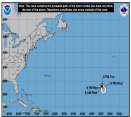cieldumort
Moderator

Reged:
Posts: 2636
Loc: Austin, Tx
|
 Inland Intensification of Tropical Cyclones
Inland Intensification of Tropical Cyclones
Tue Aug 19 2008 08:24 PM
|
|
|
Fay makes for a perfect case example of how little sea surface temperatures can mean. For all the talk about how big and bad any given tropical cyclone is going to get because it's about to go over some vast, nasty eddy of sweltering warm ocean heat content, the truth of the matter is, when it comes to tropical cyclones, sea surface temps, and in some rare cases, indeed, sea surface itself, is not the be all and end all. Far from it.
For the most part, and contrary to popular belief, in order for tropical cyclogenesis to occur, a disturbance requires sea surface temperatures at or above only 20 degrees Celsius. However, the lower range rarely cuts it, and indeed SSTs at or above 26.5 degrees C are usually required. But, in the end, there is really no "magical" number.
Also contrary to another popular myth, as alluded to in the paragraphs above, very hot sea surface temperatures on their own do not make for tenacious hurricanes, or even particularly strong hurricanes.
What both of these facts tell us is that there have to be other, even more critical, players involved. And there are. Tropical cyclones do not exist in the ocean. They exist in the air, and only glide across the oceans (and land). So, as logic would have it, these other, critical players, also exist in the atmosphere; not in the ocean.
Fay strengthened inland for several reasons. The most likely are:
1) Outflow. Fay's outflow in all quadrants improved radically going into and after landfall. This upper-level vacating of air from the surface-up allowed her thunderstorms to evacuate very efficiently aloft, and strengthen mightily. In turn, more air rushed in at the surface, and exited aloft.
This process lowers the pressure inside a cyclone, and no surprise, Fay went from 1003mb or so at 11AM Monday, down to 986mb (often associated with Cat 1 hurricanes!) by the same time today.
2) Lack of friction. Florida is a very flat state. Unlike most landfall locations, there simply aren't many, if any, hills and valleys and other obstacles that usually work to gnaw away at a tropical cyclone's windflow..
3) Moisture content. Fay was always wrapped in a fairly moist envelope. Having been born from within a water vapor balloon that was her mid-level circulation and associated upper-level anticyclone, most of this fetch of deep, tropical air followed her everywhere she went. Then, upon entering Florida, Fay was greeted by yet more warm, moist atmosphere - even the ground was frequently like traveling over a very warm, shallow ocean.
4) Momentum. Fay was intensifying rather impressively right into landfall.
These kinds of events are not unprecedented. However, they are rare. Most recently, there was a lot of debate as to whether or not time should have been added to Tropical Storm Erin (2007), as when she entered Oklahoma, there for about six hours, Erin saw a very substantial pressure fall, along with sustained winds of at least minimal tropical storm force over a sizable area, widespread, deadly torrential rains, gusts fully at hurricane-force, and even an eye-like feature visible on radar and a little bit on IR channels.
I have included the image of Erin's track below (Green designates Depression. Yellow, Storm)

And here is what Erin looked like while over central Oklahoma

Read more about Erin's wacky inland resurrection here, and here, and here (NHC) PDF.
|
|




 Flat
Flat






